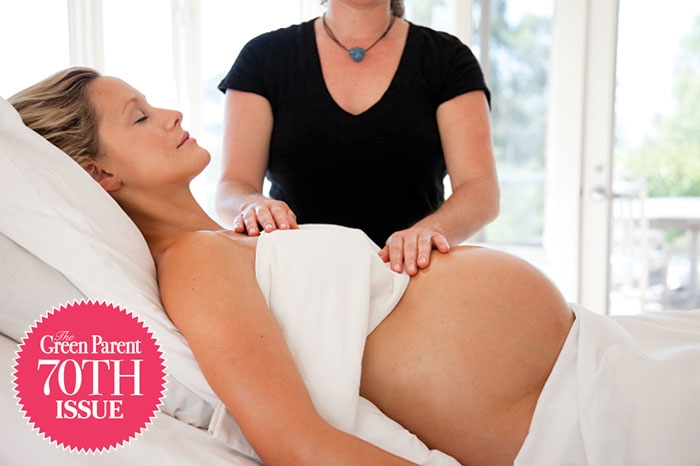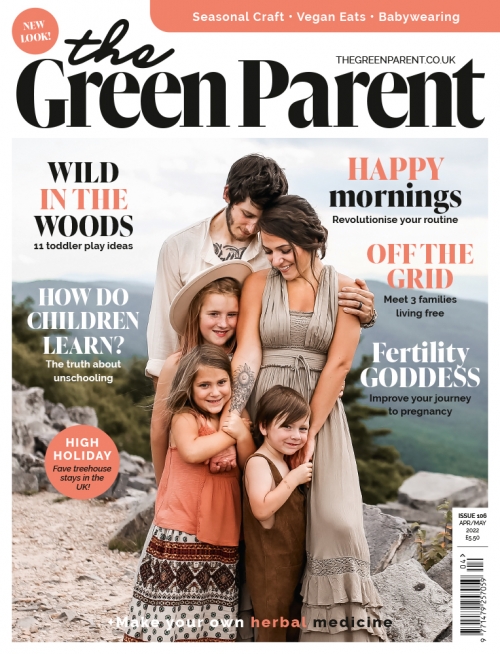This is one of the top twenty stories published in The Green Parent magazine from the last seventy issues. Want to read everything? This is just one of thousands of articles we’ve published. Read all our back issues online here – over 7,000 pages of content at your fingertips for £4.
Now that my firstborn is almost two, I can look back fondly on his birth and remember only the wonderful bits about it. Indeed, compared to the experiences of many women, I feel blessed that it was so straight-forward. And yet, if two fundamental factors had not been in play, I know for certain things could have been very different.
The primary factor was of course me: since falling pregnant I had researched the history, process and other’s experiences of childbirth thoroughly to give myself (and hubby) the best possible grounding for what to expect. I joined a home-birth group and met a wonderful group of people, from new mums and second or third-time mums to midwives, doulas and dads – all with fountains of knowledge and experience to impart. We hired a doula and we took part in a Natal Hypnotherapy course. In addition to all of this, I allowed myself to recognise and follow my own instincts – a tool which has proved its value time and time again through both birth and parenting.
In addition, I could not have done without my fantastic midwifery care. The NHS midwives who attended my birth were beautiful women who respected our birth plan without comment and attended to our needs without interfering. Having said this, pre-birth we were not without our issues with the NHS model of care, and had it not been for our own knowledge, backed up by the invaluable advice (freely given) from an independent midwife (IM), it’s likely I would have felt pushed into a managed birth due to some minor complications throughout my pregnancy.
“Our Independant Midwife appointments were just like having a good friend round – we drank tea, chit-chatted and gossiped, laughed and confided, and took our time”
An independent midwife
Reflecting on this, and having met several lovely IMs through our home-birth group, we always said that we’d save up for one for our next child. However, when we fell pregnant again only six months after our first, our budget wouldn’t allow it and so instead we opted for minimal interaction with the NHS. All went well until my 36 week appointment, when suddenly things simply got crazy and our confidence in their care for our unborn baby was damaged. Two weeks of panic, much stress and hunting for advice, and we found ourselves booked with an IM – the lovely Louise, who had advised me during my first pregnancy.
It is often said in midwifery circles that the most important skill a midwife can master is to “drink tea intelligently”; in other words, to sit by the labouring woman, “convey[ing] confidence in [her] ability to give birth without unnecessary assistance, but [using] their intelligence and skill to judge if and when there is a need to intervene.”1 The same can be said for antenatal care – the best midwives will take their time with you, gradually building up a rapport and learning by osmosis about the family unit including any issues, fears or possible risks. Our IM appointments were just like having a good friend round – we drank tea, chit-chatted and gossiped, laughed and confided, and took our time. Somewhere in amidst all this, the salient checks were done and notes made. I knew that from this interaction she could glean so much more information than pointed and impersonal questioning; this rounded, holistic approach bolstered both my confidence and trust in her as my midwife and my own ability to birth naturally.
Medicalised model
Unfortunately, the NHS midwifery model often finds such an approach an impossible task. While some NHS midwives are blessed with a rare and golden ability to juggle duty, regulations and genuine care all at once, it is not the norm. Super-powers aside, it is in their best interests to probe and test and scan and meddle (think: 15-minute foetal heart-rate checks, internal examinations to check dilation, directed pushing), because that is what they are paid to do under the medicalised model of care. For better or worse, it is also what we expect from them – after all they are far the more experienced party when it comes to birth, so we naturally assume that all of the tests and probings are an essential part of a successful birth. But is this really the case?
The presiding factor over my desire to have a home-birth was my instinctive dislike of hospitals. Why would I want to give birth in a strange institution filled with strange, bustling people in white coats, continually reading monitors and twiddling knobs on strange machines, if I could instead give birth in the comfort, safety and security of my own familiar (and familial) home? Both our children’s births took place at home, filled with familiar sights and smells; bed linen, candles, family dog, woodburning stove, kettle, books, drinks and snacks. After each birth we fell asleep as a family and awoke together, in our own bed and on our own terms.
Normal, natural process
Of course, not many people share my mistrust of hospitals these days. To most they are revered, hallowed halls of medical authority and expertise. And that is a perfectly sound opinion to have. However, what we have forgotten in the last half-century or so, is that birth is not a medical condition. Whilst it is right and proper that we improve our medical knowledge about childbirth, we must beware falling into the trap of believing medicalised birth to be the only way. Birth is a normal, physiological process, just like eating or excreting. Hard work, physically and psychologically demanding, and utterly life-changing – but perfectly normal. There are many similar risks associated with building your own house, but you wouldn’t dream of asking the NHS to help you out unless you actually suffered an accident or trauma. The truth is, we have lost faith in our own bodies and have sold them to our healthcare system in which we have much more faith; as Lee Seekings Norman summarises in her article on normal birth: “There is a public perception that the care on offer must be the best because there is a fundamental belief that healthcare in the UK is amongst the best in the world and that, therefore, it is childbirth and women’s bodies which fail.”2
Why, for example, can we take for granted (and with not a little delight/amusement/titilation) the ability of the male sexual organ to enlarge to several times its normal size once stimulated to do so, but cannot understand that the female cervix does something very similar during labour? And why, as empowered, modern women, are we not also celebrating and bragging about such a feat? Incidentally, the analogy does not stop there, for the self-same factors which might prevent male arousal will also halt effective labour – most notoriously self-doubt, external interruptions, an ineffective partner, and lack of continuity, such as being told to do one thing, probed and prodded a bit (by a different person), and then told you’re not doing it properly (by someone else again) and if you don’t try harder you’ll have to give up.
“Pre, during, and post-birth, our Independent Midwife care was worth every scraped-together, hard-earned penny”
Protecting privacy
It is highly unfortunate, given our faith in the system, that despite their official aims and literature endorsing “natural” birth, the NHS is simply not geared towards supporting it effectively. Michael Odent’s premise that stimulation of the neocortex during labour inhibits the release of essential birthing hormones should ideally be every midwife’s mantra, yet normal procedures insist upon intervention of this kind: “How is the neocortex stimulated? It can be done in a number of ways: by asking the labouring mother to answer questions that require thought, by being near her in a way that makes her feel self-conscious, by subjecting her to bright light, and by failing to protect her privacy.”3
This undoubtedly boils down to the fact that we have forced an instinctively social event into a medicalised model, whereby “both midwives and doctors… cannot respect individual initiatives but need people to conform to the organisational norms and established authority in order to cope with lack of resources and understaffing.”4
Moreover, and much more worryingly, the statistics concerning our birth rates reveal that the NHS is acting in a most duplicitous manner, on the one hand informing women of their “rights” to a normal birth and on the other hand actively encouraging/pushing managed births for their own ends. For example, in the last 20 years, the rate of both elective and emergency caesarians has more than doubled in England, inductions and instrumental deliveries have also risen, whilst the rate of “normal” births has fallen.5 Therefore, despite their wonderful, modern medical knowledge and approach, the NHS is failing us wholesale. And why? As with all government bodies, it may simply be a matter of maths: a caesarian being worth more than double the amount in terms of funds than a normal vaginal birth to a medical trust.6
Increasingly, the threat of litigation is also an over-riding factor, and one which ensures an NHS midwife will inevitably stick to their rulebook like glue. If you request not to partake of a particular test or examination, you run the risk of having to submit to in-depth questioning and scrutiny at best; and at worst referral to social services as a ‘concern’ – and sadly, the latter is all too common. Part of the problem here is the hierarchical nature of state midwifery services: whilst it may be deemed necessary for the administration purposes of a large organisation, ultimately it means that the midwife who attends you is unable to make a judgement call based on her own knowledge and expertise. Instead she must bear in mind the rules and regulations passed down from higher up in the chain and await obstetric clearance before taking significant decisive action. Thus, meanwhile, you have undoubtedly been lying strapped to a bed listening to your monitors beeping and slowly worrying yourself into an early grave whilst nobody tells you anything definite.
An individual service
Compare this if you will with the services of an independent midwife: even though an IM cannot secure professional indemnity insurance for her practice (since insurance companies erroneously calculate midwifery risk based on obstetric risk, where compensation payouts are the largest within the health care sector*7*), her role is to support and advise the mother-to-be, whatever her wishes and outlook, and ultimately to provide a tailored service whilst preserving the sanctity of birth for what it is.
Pre, during, and post-birth, our IM care was worth every scraped-together, hard-earned penny. Our birth plan was discussed, not challenged; our viewpoints were taken into consideration, not wrangled over; personal preferences such as avoidance of internal exams were respected, not pitted against a rulebook. If any of our requests were unusual, our IM advised us that she was legally obliged to document the discussion, but she always worked with us to realise our wishes. Above all, Louise was an absolute rock of support and an incredible font of knowledge, expertise and experience, and that gave me the confidence to put my family’s welfare in her capable hands.
Imagine if all midwifery services were independent of the NHS (as they once were). In one fell swoop we would remove such issues and political wranglings. Midwives could be free to do the job they were trained for, which is primarily to attend your birth and quietly sit nearby, drinking their tea intelligently.
1 Barratt-Smith, “Normal Birth Can be Pain Free”, hgi.org.uk/archive/birth2.htm 2 Seekings Norman, “Believing in Normal”, aims.org.uk/Journal/Vol20No4/believingInNormal.htm 3 Gaskin, Guide to Childbirth 4 Beech, “Midwifery – Running Down the Drain”, aims.org.uk/Journal/Vol21No3/editorial.htm 5 Figures from birthchoiceuk.com 6 Beech, “Midwifery – Running Down the Drain”, aims.org.uk/Journal/Vol21No3/editorial.htm 7 independentmidwives.org.uk
Useful resources
Association for Improvements in the Maternity Services: aims.org.uk
Home Birthing: homebirth.org.uk
Independent Midwives UK: independentmidwives.org.uk
Louise Watkins, Independent Midwife (Shropshire): birthandborn.co.uk
• Zoë is a mother of two first and foremost, and a freelance writer and designer when she finds a spare moment or so. She lives on a narrowboat in North Wales with her husband, children and aging collie, and blogs regularly about natural parenting, crafts, design, life and love at giveanearthly.blogspot.com
Want to read more? Get your fix of awesome, thought-provoking articles delivered direct to your door here. The Green Parent is a bi-monthly print magazine, which costs just £8 for your first three issues. Find your tribe and get inspired!







